初中英语四个基本时态
初中英语四大时态练习题

初中英语四大时态练习题初中英语的四大时态包括一般现在时、一般过去时、一般将来时和现在进行时。
以下是针对这四种时态的练习题,帮助学生更好地掌握和运用这些时态。
一般现在时:1. 用一般现在时填空:- The sun ________ (rise) in the east every day.- I ________ (go) to school by bus every morning.2. 将下列句子改为否定形式:- She speaks English very well.- They play football every weekend.3. 将下列句子改为一般疑问句,并给出肯定和否定回答:- He likes to read books.- We have a meeting at 3 PM.一般过去时:4. 用一般过去时填空:- She ________ (visit) her grandparents last weekend.- They ________ (have) a party yesterday.5. 将下列句子改为否定形式:- He played basketball yesterday.- She watched a movie last night.6. 将下列句子改为一般疑问句,并给出肯定和否定回答:- They went to the beach last summer.- I saw a movie last Friday.一般将来时:7. 用一般将来时填空:- I ________ (take) a trip next month.- We ________ (have) a test on Friday.8. 将下列句子改为否定形式:- He will go to the concert tomorrow.- She will finish her homework tonight.9. 将下列句子改为一般疑问句,并给出肯定和否定回答:- They will visit the museum next week.- I will start a new job next month.现在进行时:10. 用现在进行时填空:- Look! The children ________ (play) in the park. - Listen! She ________ (sing) in the next room.11. 将下列句子改为否定形式:- He is reading a book now.- They are watching TV.12. 将下列句子改为一般疑问句,并给出肯定和否定回答: - She is cooking dinner.- We are going to the cinema tonight.答案:1. rises, go2. She doesn't speak English very well. They don't playfootball every weekend.3. Does he like to read books? Yes, he does. / No, he doesn't. Do we have a meeting at 3 PM? Yes, we do. / No, we don't.4. visited, had5. He didn't play basketball yesterday. She didn't watch a movie last night.6. Did they go to the beach last summer? Yes, they did. / No, they didn't. Did I see a movie last Friday? Yes, I did. / No,I didn't.7. will take, will have8. He won't go to the concert tomorrow. She won't finish her homework tonight.9. Will they visit the museum next week? Yes, they will. / No, they won't. Will I start a new job next month? Yes, I will. / No, I won't.10. are playing, is singing11. He isn't reading a book now. They aren't watching TV.12. Is she cooking dinner? Yes, she is. / No, she isn't. Are we going to the cinema tonight? Yes, we are. / No, we aren't.。
初中英语时态8种基本时态讲解
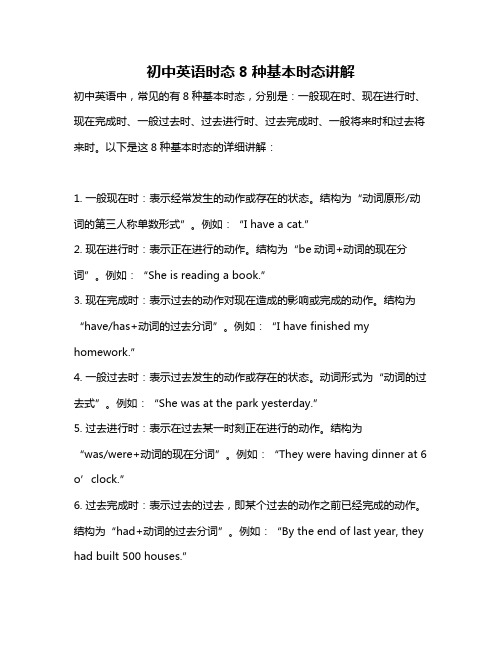
初中英语时态8种基本时态讲解初中英语中,常见的有8种基本时态,分别是:一般现在时、现在进行时、现在完成时、一般过去时、过去进行时、过去完成时、一般将来时和过去将来时。
以下是这8种基本时态的详细讲解:1. 一般现在时:表示经常发生的动作或存在的状态。
结构为“动词原形/动词的第三人称单数形式”。
例如:“I have a cat.”2. 现在进行时:表示正在进行的动作。
结构为“be动词+动词的现在分词”。
例如:“She is reading a book.”3. 现在完成时:表示过去的动作对现在造成的影响或完成的动作。
结构为“have/has+动词的过去分词”。
例如:“I have finished my homework.”4. 一般过去时:表示过去发生的动作或存在的状态。
动词形式为“动词的过去式”。
例如:“She was at the park yesterday.”5. 过去进行时:表示在过去某一时刻正在进行的动作。
结构为“was/were+动词的现在分词”。
例如:“They were having dinner at 6 o’clock.”6. 过去完成时:表示过去的过去,即某个过去的动作之前已经完成的动作。
结构为“had+动词的过去分词”。
例如:“By the end of last year, they had built 500 houses.”7. 一般将来时:表示将来要发生的动作或存在的状态。
结构为“will+动词原形”或“am/is/are going to+动词原形”。
例如:“We will visit the museum next week.”8. 过去将来时:表示从过去的某一时刻看,将来要发生的动作或存在的状态。
结构为“would+动词原形”或“was/were going to+动词原形”。
例如:“He said he would come back soon.”以上就是初中英语8种基本时态的讲解,希望对你有帮助!。
英语作文四大时态范文初中

英语作文四大时态范文初中Sure, here are four sample essays on the four major English tenses: present simple, present continuous, past simple, and future simple. Each essay is tailored to a different tense:1. Present Simple Tense:Title: My Daily Routine。
I wake up at 6 a.m. every morning. After getting out of bed, I brush my teeth and take a shower. Then, I have breakfast with my family. After breakfast, I walk to school. Classes start at 8 a.m. and finish at 3 p.m. In the evening, I do my homework and study for exams. After dinner, I relax by watching TV or playing games. Finally, I go to bedaround 10 p.m. This is my daily routine.2. Present Continuous Tense:Title: A Busy Day。
Right now, I am sitting at my desk and writing this essay. Later today, I am meeting my friends for lunch at a new restaurant. After that, we are going shopping for clothes. In the evening, I am attending a concert with my family. The band is playing at the stadium downtown. I am really excited about it. Tomorrow, I am going to the beach with my cousins. We are planning to build sandcastles and swim in the ocean. I love spending time with my family and friends.3. Past Simple Tense:Title: Last Summer Vacation。
初中英语时态8种基本时态归纳
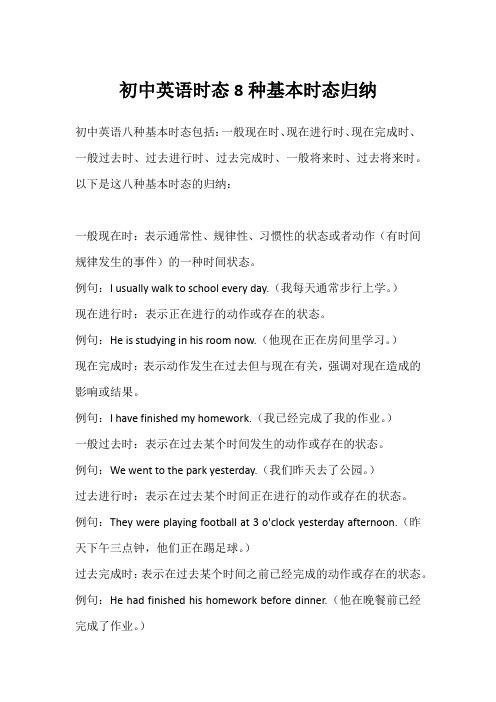
初中英语时态8种基本时态归纳初中英语八种基本时态包括:一般现在时、现在进行时、现在完成时、一般过去时、过去进行时、过去完成时、一般将来时、过去将来时。
以下是这八种基本时态的归纳:一般现在时:表示通常性、规律性、习惯性的状态或者动作(有时间规律发生的事件)的一种时间状态。
例句:I usually walk to school every day.(我每天通常步行上学。
)现在进行时:表示正在进行的动作或存在的状态。
例句:He is studying in his room now.(他现在正在房间里学习。
)现在完成时:表示动作发生在过去但与现在有关,强调对现在造成的影响或结果。
例句:I have finished my homework.(我已经完成了我的作业。
)一般过去时:表示在过去某个时间发生的动作或存在的状态。
例句:We went to the park yesterday.(我们昨天去了公园。
)过去进行时:表示在过去某个时间正在进行的动作或存在的状态。
例句:They were playing football at 3 o'clock yesterday afternoon.(昨天下午三点钟,他们正在踢足球。
)过去完成时:表示在过去某个时间之前已经完成的动作或存在的状态。
例句:He had finished his homework before dinner.(他在晚餐前已经完成了作业。
)一般将来时:表示将来的动作或状态,通常与“will”或“shall”连用。
例句:It will rain tomorrow.(明天会下雨。
)过去将来时:表示在过去某个时间之后将要发生的动作或存在的状态,通常与“would”连用。
例句:He said he would come to see me the next day.(他说他第二天会来看我。
)。
初中英语四种时态归纳总结
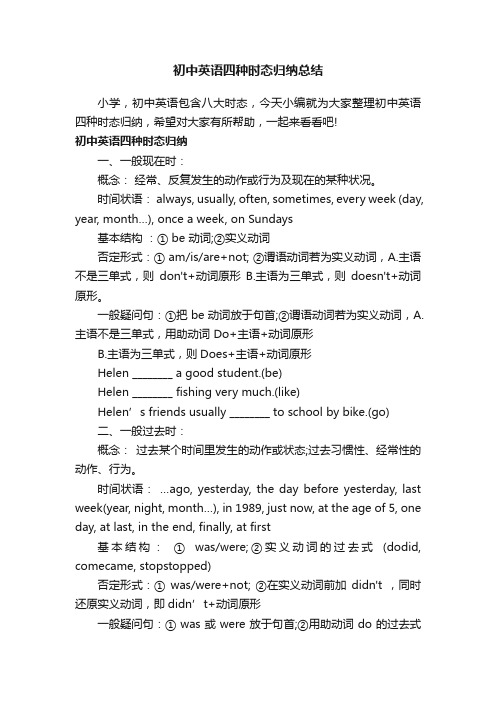
初中英语四种时态归纳总结小学,初中英语包含八大时态,今天小编就为大家整理初中英语四种时态归纳,希望对大家有所帮助,一起来看看吧!初中英语四种时态归纳一、一般现在时:概念:经常、反复发生的动作或行为及现在的某种状况。
时间状语: always, usually, often, sometimes, every week (day, year, month…), once a week, on Sundays基本结构:① be 动词;②实义动词否定形式:① am/is/are+not; ②谓语动词若为实义动词,A.主语不是三单式,则don't+动词原形B.主语为三单式,则doesn't+动词原形。
一般疑问句:①把 be 动词放于句首;②谓语动词若为实义动词,A.主语不是三单式,用助动词 Do+主语+动词原形B.主语为三单式,则Does+主语+动词原形Helen ________ a good student.(be)Helen ________ fishing very much.(like)Helen’s friends usually ________ to school by bike.(go)二、一般过去时:概念:过去某个时间里发生的动作或状态;过去习惯性、经常性的动作、行为。
时间状语:…ago, yesterday, the day before yesterday, last week(year, night, month…), in 1989, just now, at the age of 5, one day, at last, in the end, finally, at first基本结构:①was/were;②实义动词的过去式(dodid, comecame, stopstopped)否定形式:①was/were+not; ②在实义动词前加didn't ,同时还原实义动词,即didn’t+动词原形一般疑问句:① was 或 were 放于句首;②用助动词 do 的过去式did 提问,同时还原实义动词。
初中英语四大时态知识点1

一般现在时一, 概念:1)常常性, 习惯性的动作或存在的状态。
标记词或短语(带有表示频率的时间状语): always , everyday , often , once a week (month , year , etc。
) ,never, sometimes , seldom , usually等等She only write to her family once a month.她一个月只给家里写一封。
I go to work by bike every day。
我每天骑自行车上班。
2)表示主语的特征, 性格, 实力, 爱好等。
e.g.He can swim. I work hard. I like watching TV.3)表示客观真理e.g.There are seven days in a week.The sun rises in the east 。
日出东方。
Ten minus two is eight。
十减二等于八。
Light travels faster than sound 。
光的速度比声音的速度快。
The United States lies by the west coast of the Pacific Ocean.美国位于太平洋西岸。
4) 依据英文语法规定, 当主句的谓语动词是一般将来时, 那么时间或条件状语从句的谓语动词只能用一般现在时来表示将来要发生的动作。
主句表将来, 从句要用一般现在时。
例:I'll tell him the news when he comes back.他回来时,我将告知他这个消息。
If you take the job , they will talk with you in greater details。
假如你接受这份工作, 他们将和你谈谈细微环节。
二, 句式结构:1)主语+be动词+其他2)主语+行为动词+其他三, 句式转换1)be 动词的一般现在时的句式转换:确定句 主语 ♌♏表语☎⏹ ♋♎等✆否定句 主语 ♌♏ ⏹☐♦表语一般疑问句: ♏主语 表语回答:✡♏♦ 主语 ♌♏☠☐ 主语 ♌♏ ⏹☐♦特别疑问句 疑问词 ♌♏主语 回答 主语 ♌♏其它2).实义动词的一般现在时的句式转换:①假如主语是I/We/You/They及名词复数, 谓语动词不用做任何变化, 即仍旧用动词原形表示:确定句: 主语+动词原形+其他否定句: 主语+don't+动词原形+其他一般疑问句:Do+主语+动词原形+其他回答: Yes,主语+do./No,主语+don't .特别疑问句: 特别疑问词+do+主语+动词原形+其他②主语是第三人称单数,确定句: 主语+动词的第三人称单数+其他否定句: 主语+doesn't+动词原形+其他一般疑问句: Does+主语+动词原形+其他回答: Yes, 主语+does /No, 主语+doesn't特别疑问句: 特别疑问词+ does+主语+动词原形+其他E.g.Danny is a good student. E.g. Jenny speaks English very well.Danny isn’t a good student.Jenny doesn’t speak English very well.Is Danny a good student Does Jenny speak English very well四, 动词三单变化规律1)一般动词, 在词尾加-s; 如:work -- works live --lives sing – sings2) 以,-s, -x, -sh, -ch结尾的加-es。
初中英语基础语法必会八种基本时态

初中英语基础语法必会八种基本时态1. 一般现在时概念:表示经常发生的动作或经常存在的状态。
常和always,often,usually,sometimes,every day等表时间的状语连用。
如:1)I go to school every day . 我每天都去学校。
(表经常)2)He is always like that . 他总是那样。
(表状态)构成:1)主语+ be (am / are / is )+……2)主语+ 实义动词/三单动词+…2.一般过去时概念:1)表示过去某个时间发生的动作或存在的状态。
常和表示过去的时间状语连用. 如:yesterday,last week,in 1998,two days ago等。
如:I went to a movie yesterday. 我昨天去看了一场电影。
2)也可表示过去经常或反复发生的动作。
如:He always went to work by bike last week.构成:1)主语+ be (was / were)+……2)主语+实义动词过去式3. 现在进行时概念:表示现在(说话瞬间)正在进行或发生的动作。
如:He is singing.They are watching TV now.构成:主语+助动词be(am/are/is)+动词-ing形式构成。
4. 过去进行时概念:表示过去某一时刻或某一段时间正在进行的动作. 这一特定的过去时间除了有上下文暗示外,一般用时间状语来表示。
如:1)——What were you doing?——I was jumping.2)——What was the boy doing when the UFO arrived?——He was sleeping.构成:主语+助动词be(was/were)+动词-ing形式构成。
5. 一般将来时概念:表示将来某个时间要发生的动作或存在的状态,也表示将来经常或反复发生的动作,常与表示将来的时间状语连用,如:tomorrow,next week,next year,in the future等.如:He will go shopping tomorrow.They are going to play basketball next week.构成:1)主语+助动词will +动原+…2)主语+ be going to +动原+….6. 过去将来时概念:表示在过去将来的某一时间发生的动作或存在的状态。
英语四大时态教案模板初中

#### 教学目标1. 让学生理解并掌握英语的四大时态:一般现在时、现在进行时、一般过去时和一般将来时。
2. 通过练习,使学生能够正确运用这些时态进行日常对话和写作。
3. 培养学生辨别不同时态的能力,提高他们的英语语言运用能力。
#### 教学重难点- 重点:四大时态的基本构成、用法及常见时间状语。
- 难点:不同时态之间的区别及在具体语境中的运用。
#### 教学准备- 多媒体课件- 练习题- 实物或图片辅助教学#### 教学过程##### 第一课时:一般现在时Step 1: 导入- 通过展示一些日常生活中的图片或视频,引导学生用英语描述,引出一般现在时。
Step 2: 语法讲解- 介绍一般现在时的概念和基本结构,包括肯定句、否定句和疑问句的构成。
- 讲解一般现在时的用法,如表示经常性、习惯性动作或状态。
Step 3: 练习- 通过多媒体课件进行语法填空练习,巩固所学知识。
- 分组讨论,让学生用一般现在时描述自己的日常生活。
Step 4: 小结- 总结一般现在时的用法,强调其在描述日常习惯和一般事实中的应用。
##### 第二课时:现在进行时Step 1: 复习- 复习上一节课学过的一般现在时,引入现在进行时。
Step 2: 语法讲解- 介绍现在进行时的概念和基本结构,包括肯定句、否定句和疑问句的构成。
- 讲解现在进行时的用法,如表示正在进行的动作或状态。
Step 3: 练习- 进行现在进行时的语法填空练习。
- 角色扮演,让学生用现在进行时描述正在进行的动作。
Step 4: 小结- 总结现在进行时的用法,强调其在描述正在进行的动作或事件中的应用。
##### 第三课时:一般过去时Step 1: 复习- 复习前两节课学过的一般现在时和现在进行时。
Step 2: 语法讲解- 介绍一般过去时的概念和基本结构,包括肯定句、否定句和疑问句的构成。
- 讲解一般过去时的用法,如表示过去某个时间发生的动作或状态。
Step 3: 练习- 进行一般过去时的语法填空练习。
初中英语八种基本时态总结
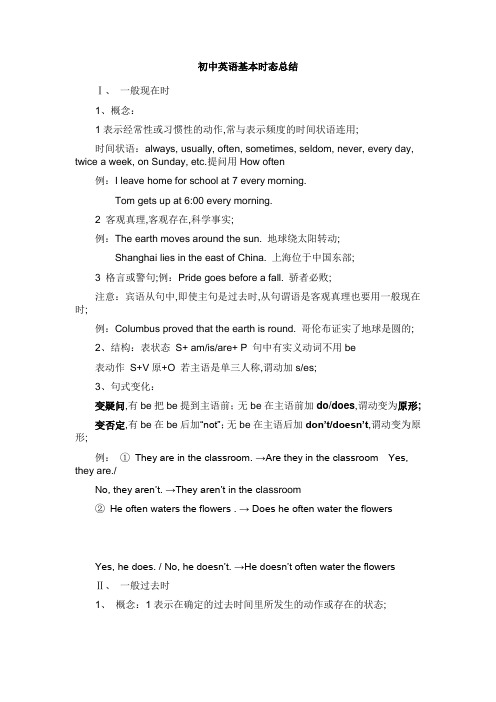
初中英语基本时态总结Ⅰ、一般现在时1、概念:1表示经常性或习惯性的动作,常与表示频度的时间状语连用;时间状语:always, usually, often, sometimes, seldom, never, every day, twice a week, on Sunday, etc.提问用How often例:I leave home for school at 7 every morning.Tom gets up at 6:00 every morning.2 客观真理,客观存在,科学事实;例:The earth moves around the sun. 地球绕太阳转动;Shanghai lies in the east of China. 上海位于中国东部;3 格言或警句;例:Pride goes before a fall. 骄者必败;注意:宾语从句中,即使主句是过去时,从句谓语是客观真理也要用一般现在时;例:Columbus proved that the earth is round. 哥伦布证实了地球是圆的;2、结构:表状态S+ am/is/are+ P 句中有实义动词不用be表动作S+V原+O 若主语是单三人称,谓动加s/es;3、句式变化:变疑问,有be把be提到主语前;无be在主语前加do/does,谓动变为原形;变否定,有be在be后加“not”;无be在主语后加don’t/doesn’t,谓动变为原形;例:①They are in the classroom. →Are they in the classroom Yes, they are./No, they aren’t. →They aren’t in the cl assroom②He often waters the flowers . → Does he often water the flowersYes, he does. / No, he doesn’t. →He doesn’t often water the flowersⅡ、一般过去时1、概念:1表示在确定的过去时间里所发生的动作或存在的状态;常用时间状语:yesterday, the day before yesterday, last week, just now, an hour ago, the other day, in 1982. at the age of 5, one day, long long ago, etc.例:Where did you go just now2表示在过去一段时间内,经常性或习惯性的动作;例:When I was a child, I often played football in the street.2、结构:表状态S+ was/were+ P表动作S+V过去式+O 注:句中有实义动词不用be3、句式变化:变疑问,有be把be提到主语前;无be在主语前加did,谓动变为原形;变否定,有be在be后直接加“not”;无be在主语后加didn’t,谓动变为原形.例:①She was in Xi’an last month. → Was she in Xi’an last monthYes, she was. /No, she wasn’t. →She wasn’t in Xi’an last month.②Danny grew a rose just now, → Did Danny grow a rose just nowYes, he did. / No, he didn’t. →Danny didn’t grow a rose just now,Ⅲ、现在进行时:1. 概念:表示现阶段或说话时正在进行的动作;时间状语:now, at this time, these days,以及有look, listen时;例:ListenThe birds are singing.2、结构:S + am/is/are + doing助动现在分词3、句式变化:变疑问,把am/is/are提到主语前;变否定,在am/is/are后直接加“not”;例:①I am writing a letter now. → Are you writing a letter nowYes, I am. /No, I’m not. →I am not writing a letter now. 注:am和not不能缩写;②The boys are playing football. → Are the boys playing footballYes, they are. / No, they aren’t. →The boys aren’t playing football.Ⅳ、过去进行时:1. 概念:表示过去某段时间或某一时刻正在发生或进行的动作;.时间状语:at this time yesterday, at that time,at 8:00 yesterday,或有when / while引导的时间状语从句等;例:We were having an English class at 9:30 yesterday morning.I was reading a book while my mother was watching TV.2、结构:S + was/were + doing3、句式变化:变疑问,把was/were提到主语前;变否定,在was/were后直接加“not”;例:①At that time they were working in the garden. → Were they working inthe garden at that timeYes, they were. / No, they weren’t.→At that time they were working in the garden.②When he came in, I was reading a newspaper. →When he came in, were you reading a newspaperYes, I was. / No, I wasn’t.→When he came in, I wasn’t reading a newspaper.Ⅴ、一般将来时1. 概念:表示将要发生的动作或存在的状态;时间词:tomorrow, tomorrow morning, at seven o'clock tomorrow evening, next year, this year, at the end of this term, from now,in ten minutes, in 2025例:They will do an experiment tomorrow afternoon.Brian is going to draw twenty pictures at the end of this term.2、结构:S +will+ V原+其他will 可改为be going to ,当主语是第一人称时will可用shall例:Which paragraph shall I read first 我先读哪一段呢Will you/Are you going tobe at home at seven this evening3、句式变化:变疑问,把will提到主语前;变否定,在will后直接加“not”;例; She will drive to Beijing next week. → Will she drive to Beijing next weekYes, she will. / No, she won’t. →She won’t drive to Beijing next week.★be going to + V原表示a. 主语的意图,即将做某事;例:What are you going to do tomorrowb. 计划,安排要发生的事;例:The play is going to be produced next month;c. 有迹象要发生的事;例:Look at the dark clouds, there is going to be a storm.★be +不定式:表示将来,按计划或正式安排将发生的事;例:We are to discuss the report next Saturday. 我们下星期六将讨论这份报告★用现在进行时表示将来come, go, arrive, leave, start, begin, return等终止性动词可用现在进行时表示将来;例:I'm leaving tomorrow. 明天我要走了;Are you staying here till next week 你会在这儿呆到下周吗Ⅶ、现在完成时:1. 表示:①过去发生或已经完成的动作对现在造成的影响或结果;时间词:ever, never, already, yet, before, just, recently/ lately最近, in the past few years2. ②或从过去已经开始持续到现在的动作或状态; 时间词:for + 时间段,since +过去时间点/从句;提问用How long例:The countryside has changed a lot in the past few years.He has learned French for two years.2.结构:S + have/has + done助动过去分词3. 句式变化:变疑问,把have/has提到主语前;变否定,在have/has后直接加“not”;例:①I've already written an article. → Have you written an article yet Yes, I h ave. / No, I haven’t. →I haven’t written an article yet.②Li Ming has lived in Shijiazhuang since 1993.→ Has Li Ming lived in Shijiazhuang since 1993 Yes, he has. / No, he hasn’t.→Li Ming hasn’t lived in Shijiazhuang since 1993.★比较一般过去时与现在完成时1一般过去时表示过去某具体时间发生的动作或单纯叙述过去的事情,强调动作;现在完成时则强调过去发生的动作对现在的造成影响,强调的是结果;2一般过去时常与具体的时间状语连用,而现在完成时通常与模糊的时间状语连用,或无时间状语;例:I saw this film yesterday. 强调看的动作发生过了I have seen this film. 强调对现在的影响,电影的内容已经知道了Why did you get up so early 强调起床的动作已发生过了Who hasn't handed in his paper 强调有卷子未交,指结果He joined the League three years ago. 强调加入这一动作He has been a League member for three years. 是团员的状态可持续句子中如有过去时的时间副词如yesterday, last, week, in 1960时,不能使用现在完成时,要用过去时;错Tom has written a letter to his parents last night.对Tom wrote a letter to his parents last night.。
初中英语语法——四大基本时态课件(共24张ppt)

现在进行时使用环境、句型变化
★作谓语的动词用来表示动作(情况)发生时间的 各种形式称为时态。
★概念:表示现阶段或说话时正在进行的动作及行 为。
★时间状语:Now, at this time, days, look. listen等时 间状语做标志。
★基本结构:主语+be +doing +其他 ★否定形式:主语+be +not +doing+其他 ★一般疑问句:把be动词放于句首。
事,正要做某事。 ⑤某些动词,可用进行时态表将来,如come,
现在进行时的用法
1)、现在(说话的瞬间)正在进行或发生的动作,强调“此时此刻” E.g. He is reading . They are talking now.
2)、当前一段时间内的活动或现阶段正在进行的动作。 E.g. They are working these days.
3)、 某些动词的现在进行时,表预定的计划或即将发生的动作。 E.g I am coming.
一般现在时--句型变化
❖ ③含有be动词的要在be上做变化.
❖
Danny is a good student. 陈述句
❖
丹尼是个好学生。
❖
Danny isn't a good student. 否定句
❖
丹尼不是个好学生。
❖
Is Danny a good student? 一般疑问句
❖
丹尼是个好学生吗?
此句中给出的do指“做,干”, not指把此句变为否定句, 故须在do前加助动词don't。
做题时常见错误五、对主语的数判断有误
初中六个英语时态总结归纳

初中六个英语时态总结归纳英语时态是学习英语语法中的重要内容之一,它能够帮助我们准确地描述过去、现在和将来的动作或状态。
在初中阶段,学生通常会接触到六个基本的英语时态,它们分别是一般现在时、一般过去时、一般将来时、现在进行时、过去进行时和将来进行时。
本文将对这六个时态进行总结归纳,帮助读者更好地理解和运用。
一、一般现在时(Simple Present Tense)一般现在时用来表达经常性或习惯性的动作、客观真理、科学事实以及对现在情况的描述。
它的基本形式是主语 + 动词原形(第三人称单数加-s/-es),且没有时间状语的限制。
例如:1. He plays basketball every Sunday.(他每个星期天打篮球。
)2. Water boils at 100 degrees Celsius.(水在100摄氏度沸腾。
)二、一般过去时(Simple Past Tense)一般过去时用来表示发生在过去某个时间的动作或状态。
它的基本形式是主语 + 动词过去式,其中一般过去时的动词过去式有规律和不规律两种形式。
例如:1. She walked to the park yesterday.(昨天她走到了公园。
)2. They saw a movie last night.(昨晚他们看了一部电影。
)三、一般将来时(Simple Future Tense)一般将来时用来表示将来会发生的动作或状态。
它的基本形式是主语 + will + 动词原形,还可以使用be going to + 动词原形的形式。
例如:1. We will have a party tomorrow.(我们明天将举办一个派对。
)2. He is going to study abroad next year.(明年他将出国留学。
)四、现在进行时(Present Continuous Tense)现在进行时用来表示现在正在进行的动作或状态。
初中英语中考必会时态归纳(共16种)
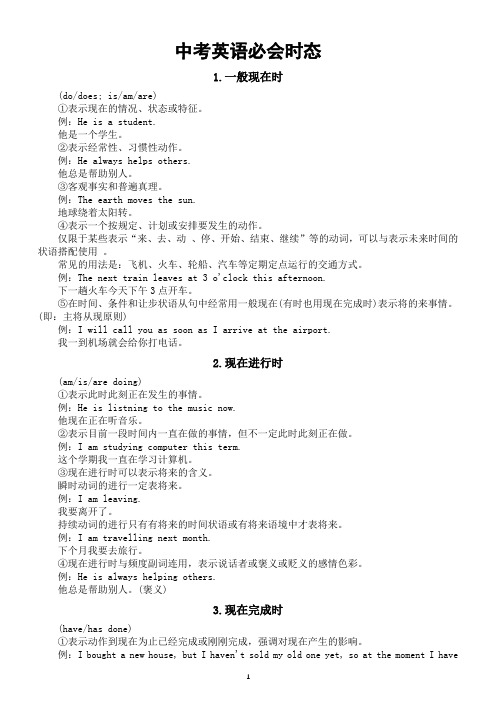
中考英语必会时态1.一般现在时(do/does; is/am/are)①表示现在的情况、状态或特征。
例:He is a student.他是一个学生。
②表示经常性、习惯性动作。
例:He always helps others.他总是帮助别人。
③客观事实和普遍真理。
例:The earth moves the sun.地球绕着太阳转。
④表示一个按规定、计划或安排要发生的动作。
仅限于某些表示“来、去、动、停、开始、结束、继续”等的动词,可以与表示未来时间的状语搭配使用。
常见的用法是:飞机、火车、轮船、汽车等定期定点运行的交通方式。
例:The next train leaves at 3 o'clock this afternoon.下一趟火车今天下午3点开车。
⑤在时间、条件和让步状语从句中经常用一般现在(有时也用现在完成时)表示将的来事情。
(即:主将从现原则)例:I will call you as soon as I arrive at the airport.我一到机场就会给你打电话。
2.现在进行时(am/is/are doing)①表示此时此刻正在发生的事情。
例:He is listning to the music now.他现在正在听音乐。
②表示目前一段时间内一直在做的事情,但不一定此时此刻正在做。
例:I am studying computer this term.这个学期我一直在学习计算机。
③现在进行时可以表示将来的含义。
瞬时动词的进行一定表将来。
例:I am leaving.我要离开了。
持续动词的进行只有有将来的时间状语或有将来语境中才表将来。
例:I am travelling next month.下个月我要去旅行。
④现在进行时与频度副词连用,表示说话者或褒义或贬义的感情色彩。
例:He is always helping others.他总是帮助别人。
(褒义)3.现在完成时(have/has done)①表示动作到现在为止已经完成或刚刚完成,强调对现在产生的影响。
初中英语句子的时态
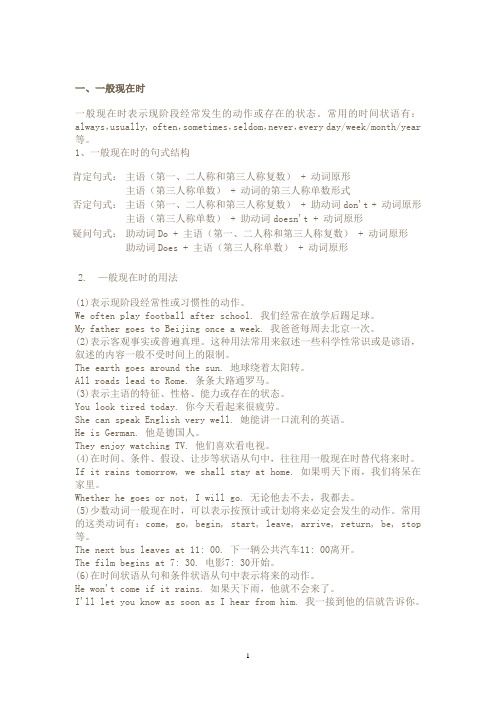
一、一般现在时一般现在时表示现阶段经常发生的动作或存在的状态。
常用的时间状语有:always,usually, often,sometimes,seldom,never,every day/week/month/year 等。
1、一般现在时的句式结构肯定句式:主语(第一、二人称和第三人称复数) + 动词原形主语(第三人称单数) + 动词的第三人称单数形式否定句式:主语(第一、二人称和第三人称复数) + 助动词don't + 动词原形主语(第三人称单数) + 助动词doesn't + 动词原形疑问句式:助动词Do + 主语(第一、二人称和第三人称复数) + 动词原形助动词Does + 主语(第三人称单数) + 动词原形2. —般现在时的用法(1)表示现阶段经常性或习惯性的动作。
We often play football after school. 我们经常在放学后踢足球。
My father goes to Beijing once a week. 我爸爸每周去北京一次。
(2)表示客观事实或普遍真理。
这种用法常用来叙述一些科学性常识或是谚语,叙述的内容一般不受时间上的限制。
The earth goes around the sun. 地球绕着太阳转。
All roads lead to Rome. 条条大路通罗马。
(3)表示主语的特征、性格、能力或存在的状态。
You look tired today. 你今天看起来很疲劳。
She can speak English very well. 她能讲一口流利的英语。
He is German. 他是德国人。
They enjoy watching TV. 他们喜欢看电视。
(4)在时间、条件、假设、让步等状语从句中,往往用一般现在时替代将来时。
If it rains tomorrow, we shall stay at home. 如果明天下雨,我们将呆在家里。
初中英语时态(四中基本时态)
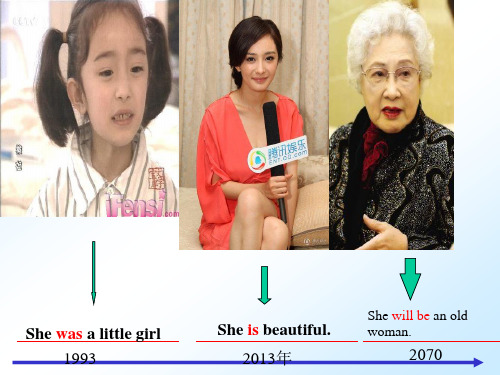
一般将来时 am/is/are going to do动词原形 Will + do
过去in the past
Now现在
将来 in the future
--What did you do last Sunday? --I played basketball. --What about your father? --He watched TV.
表示经常发生的、习惯性的动作或存 在的状态。
一般现在时的定义 2
I am a teacher.
We are students.
You are good friends.
表示人的身份地位、存在的状态。
一般现在时的定义 3
The earth goes around the sun.
The sun rises in the east.
注意:be 动词要根据主语而变化。 例:他明天将要去游泳。 He is going to swim tomorrow.
be going to句式
1、肯定句 I am going to see a film.
2、否定句
I am not going to see a film.
3、一般疑问句 Are you going to see a film? Yes, I am. No, I’m not. 4、特殊疑问句 What are you going to do ?
He is happy.
否定句:
一般疑问句:
He is not (isn’t) happy. Is he happy? Yes, he is. No, he isn’t.
肯定回答:
否定回答:
I am happy.
初中英语六大时态归纳
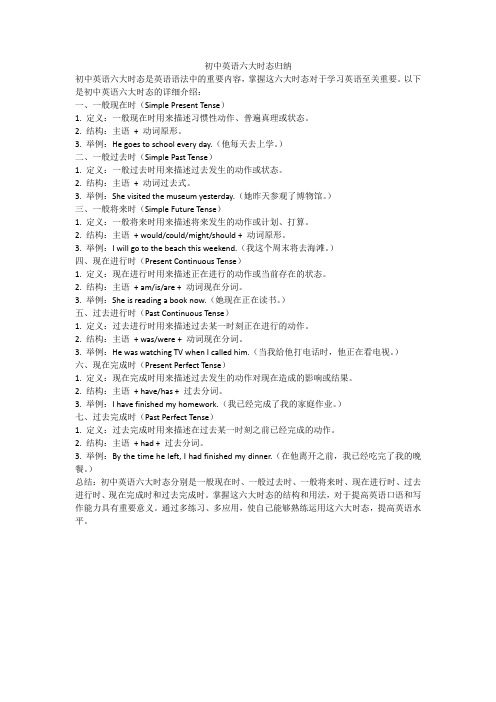
初中英语六大时态归纳初中英语六大时态是英语语法中的重要内容,掌握这六大时态对于学习英语至关重要。
以下是初中英语六大时态的详细介绍:一、一般现在时(Simple Present Tense)1. 定义:一般现在时用来描述习惯性动作、普遍真理或状态。
2. 结构:主语+ 动词原形。
3. 举例:He goes to school every day.(他每天去上学。
)二、一般过去时(Simple Past Tense)1. 定义:一般过去时用来描述过去发生的动作或状态。
2. 结构:主语+ 动词过去式。
3. 举例:She visited the museum yesterday.(她昨天参观了博物馆。
)三、一般将来时(Simple Future Tense)1. 定义:一般将来时用来描述将来发生的动作或计划、打算。
2. 结构:主语+ would/could/might/should + 动词原形。
3. 举例:I will go to the beach this weekend.(我这个周末将去海滩。
)四、现在进行时(Present Continuous Tense)1. 定义:现在进行时用来描述正在进行的动作或当前存在的状态。
2. 结构:主语+ am/is/are + 动词现在分词。
3. 举例:She is reading a book now.(她现在正在读书。
)五、过去进行时(Past Continuous Tense)1. 定义:过去进行时用来描述过去某一时刻正在进行的动作。
2. 结构:主语+ was/were + 动词现在分词。
3. 举例:He was watching TV when I called him.(当我给他打电话时,他正在看电视。
)六、现在完成时(Present Perfect Tense)1. 定义:现在完成时用来描述过去发生的动作对现在造成的影响或结果。
2. 结构:主语+ have/has + 过去分词。
初中英语基本时态

初中英语基本时态初中英语基本时态有8个,这8个基本时态如下:1.一般现在时:表示现在发生的动作、情况、状态和特征,以及经常性、习惯性动作。
例如:He always helps others.(他总是帮助别人。
)2.一般过去时:表示过去某个时间里发生的动作或状态,以及过去习惯性、经常性的动作、行为。
例如:At this time yesterday,I was doing my homework.(昨天这个时候,我正在做家庭作业。
)3.一般将来时:表示将来发生的动作或状态。
例如:The next train leaves at3 o'clock this afternoon.(下一趟火车今天下午3点开车。
)4.过去将来时:表示过去将来发生的动作或状态。
例如:He said he would goto the party.(他说他会去参加聚会。
)5.现在进行时:表示现在正在进行的动作或状态。
例如:He is studying now.(他正在学习。
)6.过去进行时:表示过去某个时间正在进行的动作或状态。
例如:At that time,they were having a meeting.(那时,他们正在开会。
)7.现在完成时:表示过去发生的动作或状态对现在造成的影响或结果。
例如:I have finished my homework.(我已经完成了我的家庭作业。
)8.过去完成时:表示过去的过去,即在过去某个时间之前已经完成的动作或状态。
例如:He said he had seen the movie before.(他说他以前看过这部电影。
)1/ 1。
- 1、下载文档前请自行甄别文档内容的完整性,平台不提供额外的编辑、内容补充、找答案等附加服务。
- 2、"仅部分预览"的文档,不可在线预览部分如存在完整性等问题,可反馈申请退款(可完整预览的文档不适用该条件!)。
- 3、如文档侵犯您的权益,请联系客服反馈,我们会尽快为您处理(人工客服工作时间:9:00-18:30)。
我以为你病了呢。(这句话应是在说话之前,我以为你病了。但是现在我知道你没病)
2.一般过去时的构成
a.动词过去式的变化可速记为“直”、“去”、“双”、“改”四字诀。
一般情况下在动词原形后直接加-ed
work—worked learn—learned want—wanted
I won’t tell herunlessshe asks me.
5)有时表示按计划,规定要发生的动作。(句中都带有时间状语词)但仅限于少数动词,如:begin, come, leave, go, arrive, start, stop, open, close等,例如:
The plane takes off at 9:30 a.m.
Will you be at home at seven this evening?
2)be going to +不定式,表示将来。
a.主语的意图,即将做某事。
What are you going to do tomorrow?
b.计划,安排要发生的事。
The play is going to be produced next month。
—Are they students? —Yes, they are. /No, they aren’t.
2)实义动词型:句中的谓பைடு நூலகம்动词为实义动词:
a.肯定句中,主语(第一、二人称和复数)+动词原形+宾语
I usually get up at 7 every morning.
b.肯定句中,主语(第三人称单数she, he, it)+动词词尾要加-S +宾语
授课讲义
动词时态
Ⅰ.一般现在时
1.一般现在时的基本用法
1)表示经常发生或反复发生的动作,常与表示频率的副词或者词组连用。如:always, usually, often, sometimes, every morning/day/week/month, once a week/month, twice a week, seldom, never等。
Heused todrink.他过去喝酒。(意味着他现在不喝酒了。喝酒这个动作终止了)
Iused totake a walk in the morning.我过去是在早晨散步。(意味着现在不在早晨散步了)
I took a walk in the morning.我曾经在早晨散过步。(只是说明过去这一动作)
b.表示过去经常反复发生的动作时,要用过去时。常与always, never, usually, often等连用。例如:
Mrs. Peter always carried an umbrella.彼得太太过去老是带着一把伞。
(只是说明她过去的动作,不表明她现在是否常带着伞。)
比较:Mrs. Peter always carries an umbrella.彼得太太老是带着伞。
以不发音的字母e结尾的动词
hope—hoped live—lived
重读闭音节单词需双写最后一个辅音字母再加-ed
stop—stopped
以辅音字母+y结尾的动词变y为i,再加-ed
study—studied worry—worried
以元音字母+y结尾的动词变y为i,再加-ed
play—played stay--stayed
4)在时间或条件从句中,须用一般现在时表示将来动作。例如:
IfI see Lucy I will ask her.
I will tell herafteryou leave.
He wants to be a teacherwhenhe grows up.
Turn off the lightsbeforeyou leave.
E.g. They are working these days.
3、某些动词的现在进行时,表预定的计划或即将发生的动作。
E.g I am coming.
其结构为be+现在分词。现在分词的变法有
1、一般在动词词尾加上-ing
2、以不发音字母e结尾的动词,先去e,再加-ing. E.g have write
3、以重读闭音节末尾只有一个辅音字母结尾的词,它前面是单个元音字母时要先将词尾的辅音字母双写,再加上-ing. E.g. sit put
其句式变换都在be上做文章。
E.g. He is buying a bike.
Is he buying a bike?
He isn‘t buying a bike.
以重读-r音节为末尾音节的词,双写-r,再加-ed
b.不规则动词变化。be动词过去式有两种形式,主语是第一、三人称单数形式使用was,其他人称用were.
c.实义动词过去式的句式
①肯定式:主语+动词过去式+其它。
如:They had a good time yesterday.
②否定式:主语+did not(didn’t)+动词原形+其它。如:
(说明这是她的习惯,表明她现在仍然还习惯总带着一把伞)
I never drank wine.我以前从不喝酒。(不涉及到现在,不说明现在是否喝酒)
I usually played basketball When I’m at school.我在学校时经常打篮球。
c.如果强调已经终止的习惯时要用used to do
watch—watches teach—teaches
pass—passes guess—guesses
wash—washes
以辅音字母+y结尾的词把y变成i加-es
study—studies carry—carries
以元音字母+y结尾的词直接加-s
play—plays buy—buys
以辅音字母+o结尾的词加-es
—Do you like oranges?
—Yes, I do. / —No, I don't.
II.现在进行时
1、现在(说话的瞬间)正在进行或发生的动作,强调“此时此刻”。
E.g. He is reading . They are talking now.
2、当前一段时间内的活动或现阶段正在进行的动作。
They didn’t watch TV last night.
③一般疑问句:Did+主语+动词原形+其它?
肯定回答:Yes,主语+did.否定回答:No,主语+didn’t.如:
Did they have a meeting two days ago?Yes,they did. / No,they didn’t.
Mr. Smith bought a new caryesterday.史密斯先生昨天买了一辆新车。
They were here onlya few minutes ago.几分钟前他们还在这里。
Lei Feng was a good soldier.雷锋是个好战士。
I bought some fishyesterday.
b.否定句中,要在be后面加not,如:
I am not ... She /He isn't... We /You /They are not...
c.一般疑问句,要将be放在句子开头,句尾用问号,答语用Yes,主语+be或No,主语+be+not.如:
—Are you ready? —你准备好了吗?—Yes,I am. /No,I'm not.
④特殊疑问句:特殊疑问词+did+主语+动词原形+其它?如:
What time did you finish your homework?
IIII.一般将来时
1)shall用于第一人称,常被will所代替。
will在陈述句中用于各人称,在争求意见时常用于第二人称。
Which paragraph shall I read first.
c.有迹象要发生的事
Look at the dark clouds, there is going to be a storm.
3)be +不定式表将来,按计划或正式安排将发生的事。
We are to discuss the report next Saturday.
4)be about to +不定式,意为马上做某事。
He is about to leave for Beijing.
注意:be about to不能与tomorrow, next week等表示明确将来时的时间状语连用。
d.有些句子,虽然没有表示过去确定时间的状语,但实际上是指过去发生的动作或存在的状态的话,也要用过去时,这一点,我们学生往往出错,要特别注意!
I didn't know you were inParis.
我不知道你在巴黎。(因为在说话时,我已经知道你在巴黎了。这句话指的是说话之前,所以只能用过去时表示。实际上,这句话暗指:But now I know you are here.)
a.表示过去某一具体时间或去过某段时间所发生的动作或曾存在的状态。过去时间可明指,也可暗指。
Did you have a partythe other day?前几天,你们开了晚会了吗?
He worked very hardlast year.去年他很用功。
It was very hot last summer.去年夏天很热。
(一般的动词词尾+S。以sh /ch /s /x结尾的词+es.以辅音加字母y结尾的把y变成i, +es。辅音字母+o结尾的+es.),为清楚明了我们在此用表格形式来说明:
